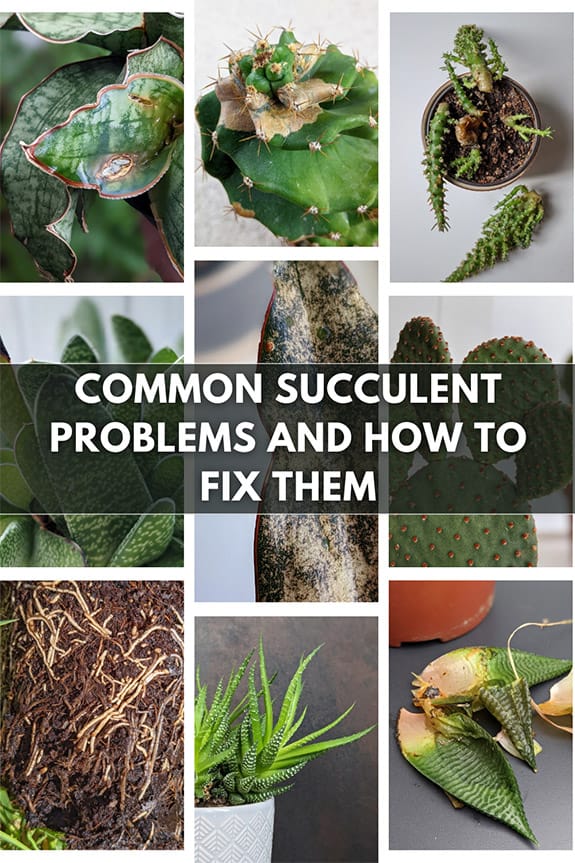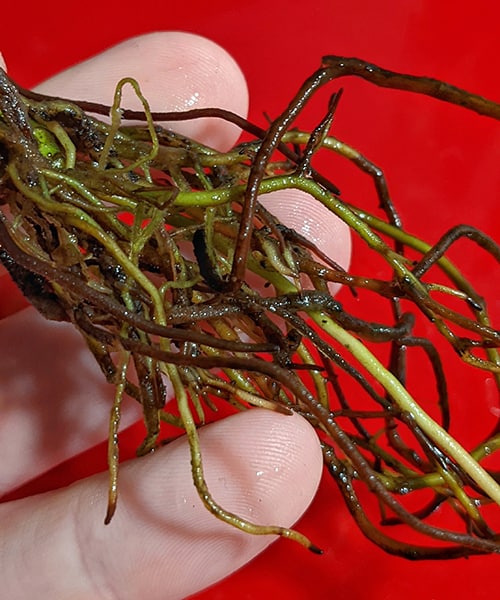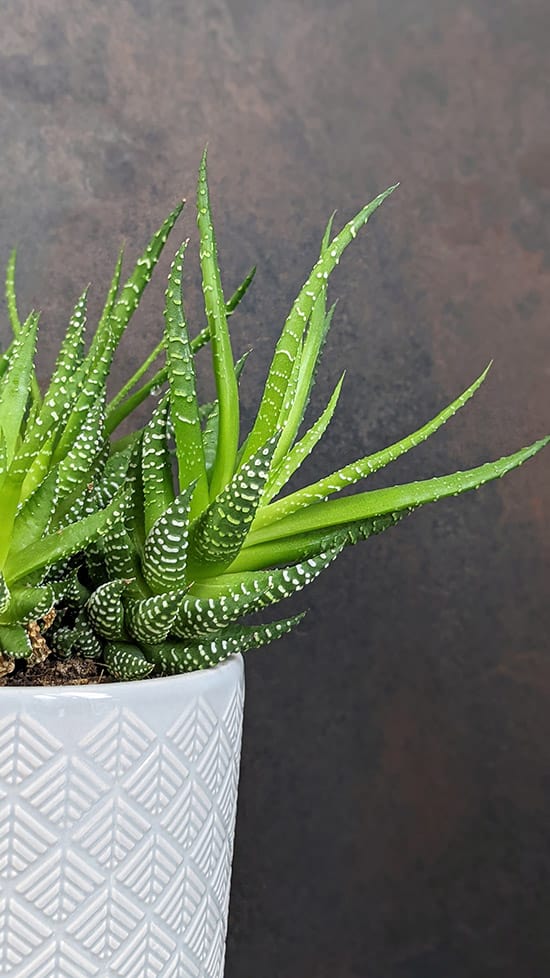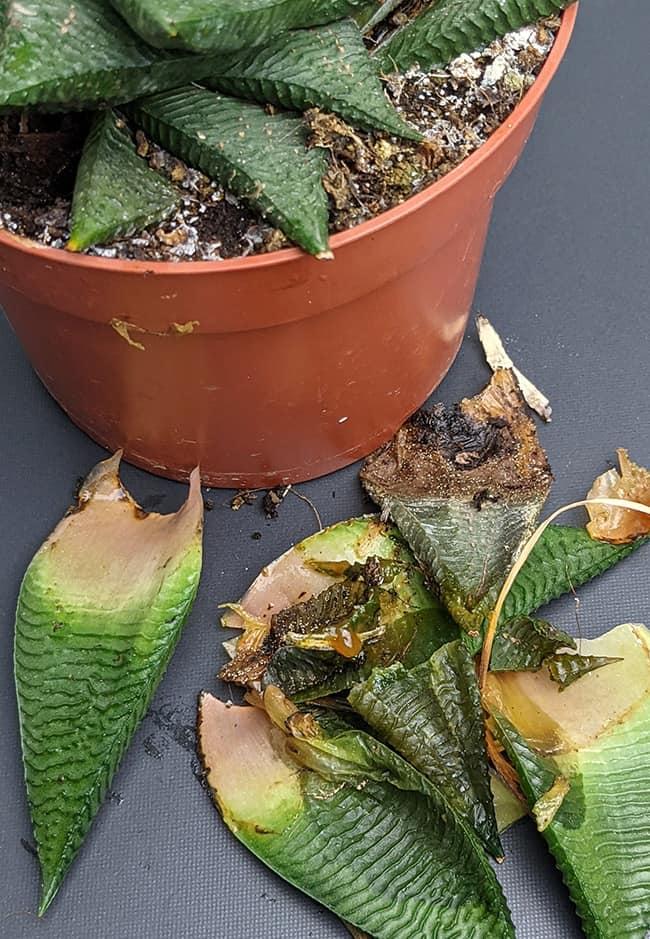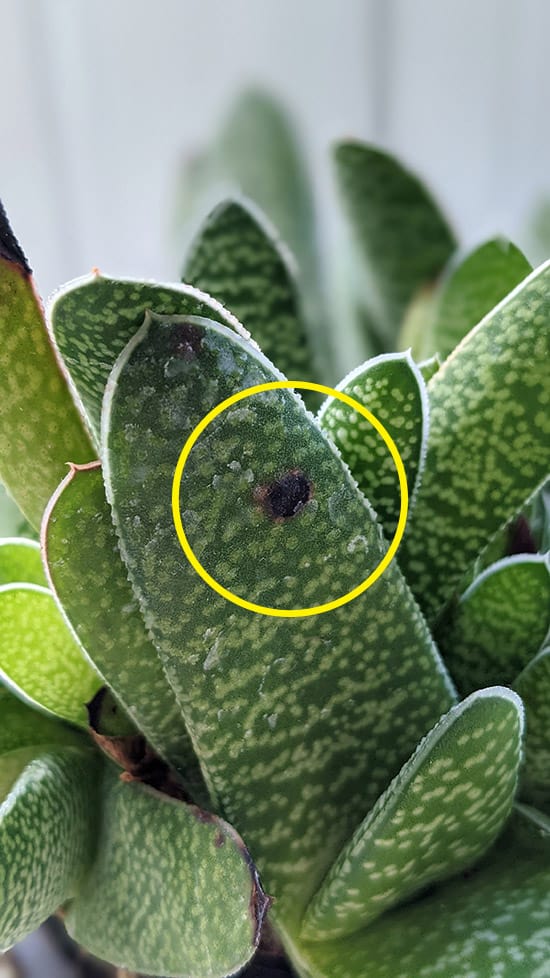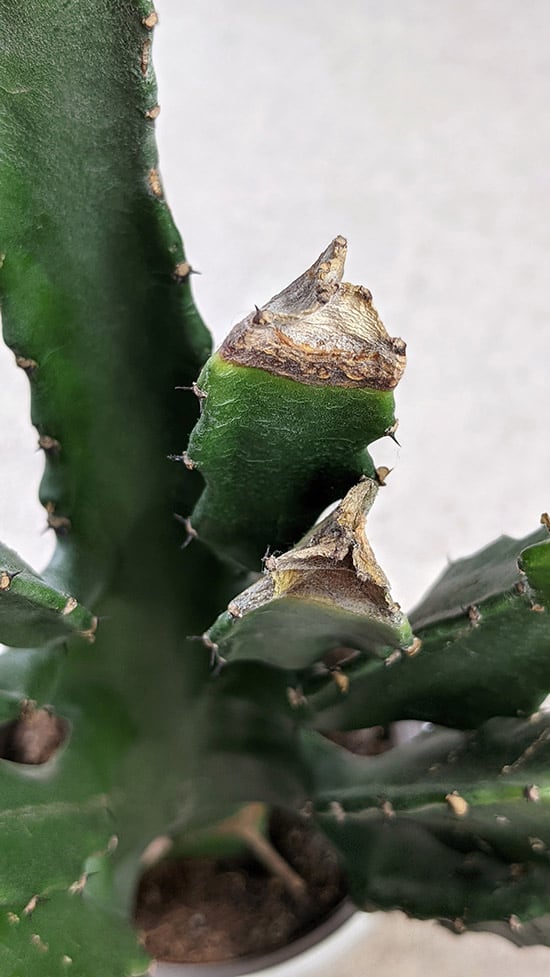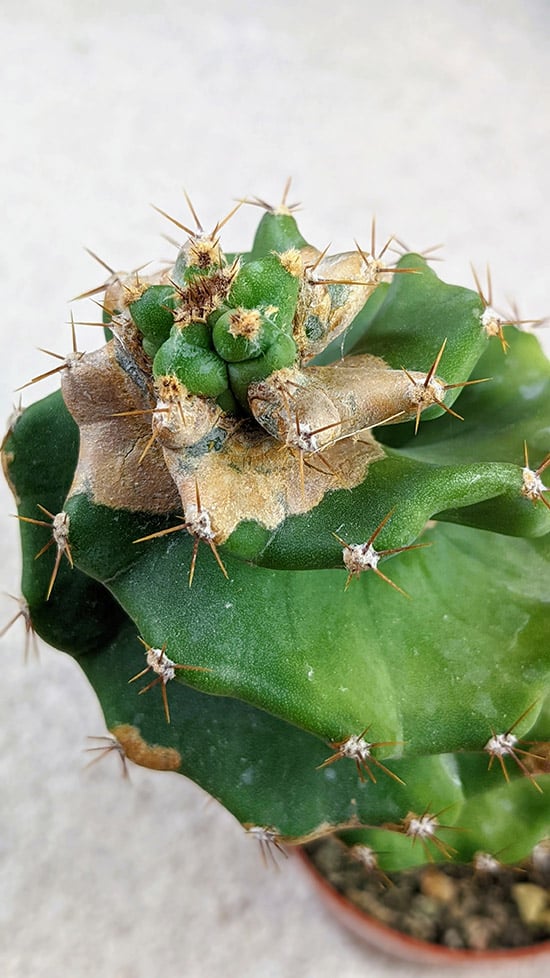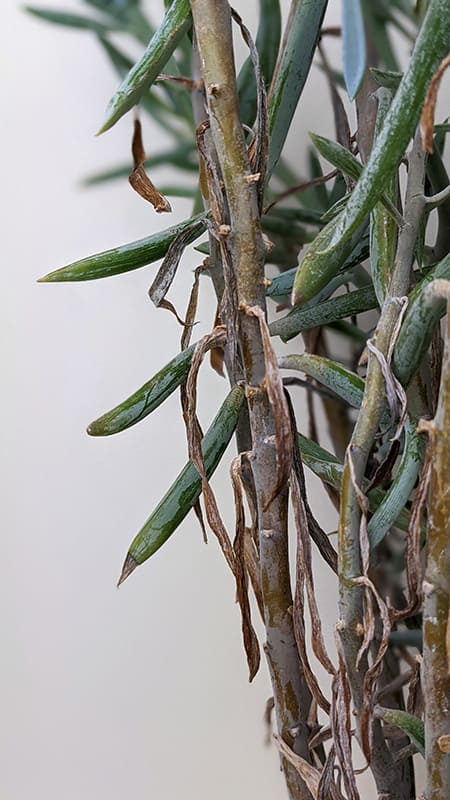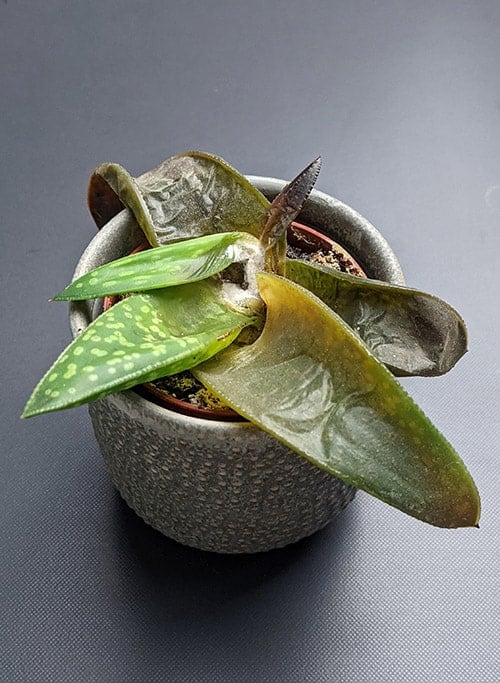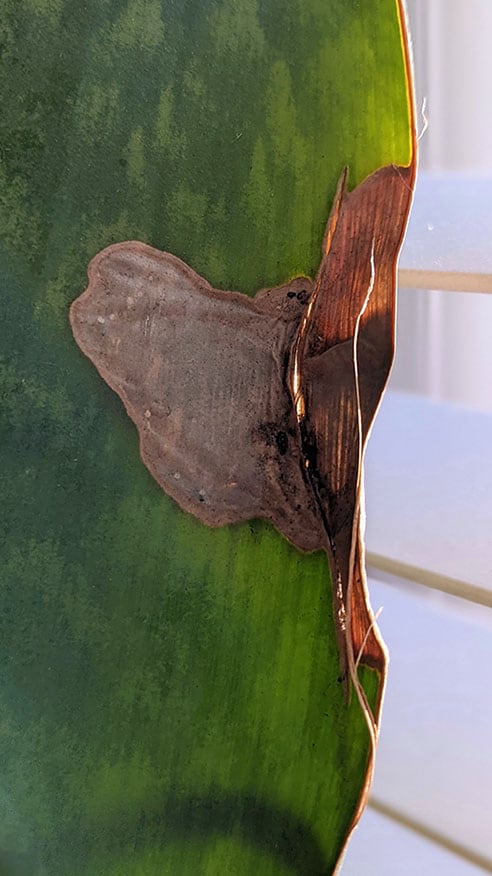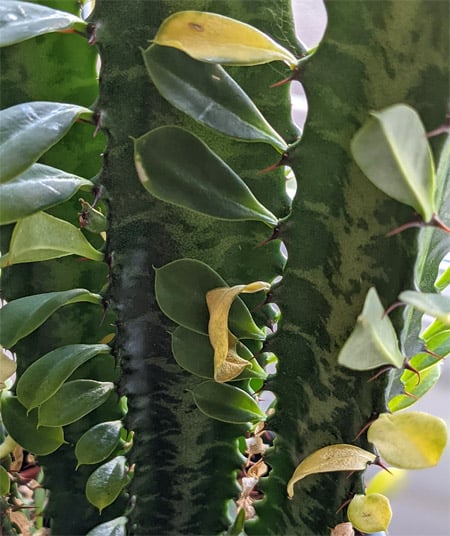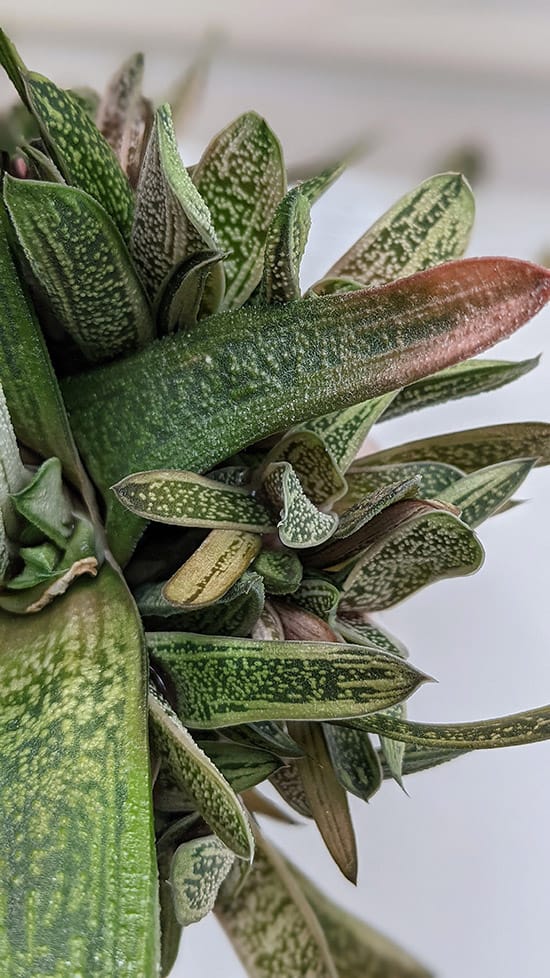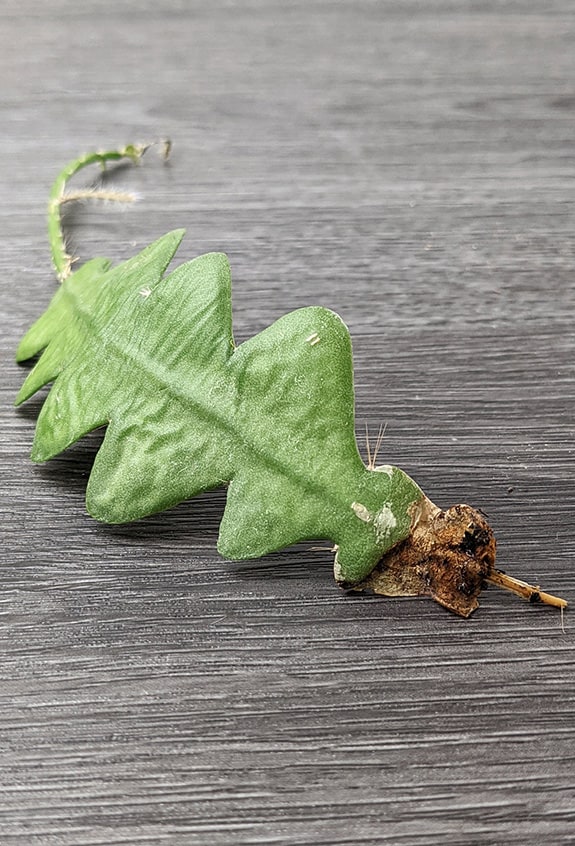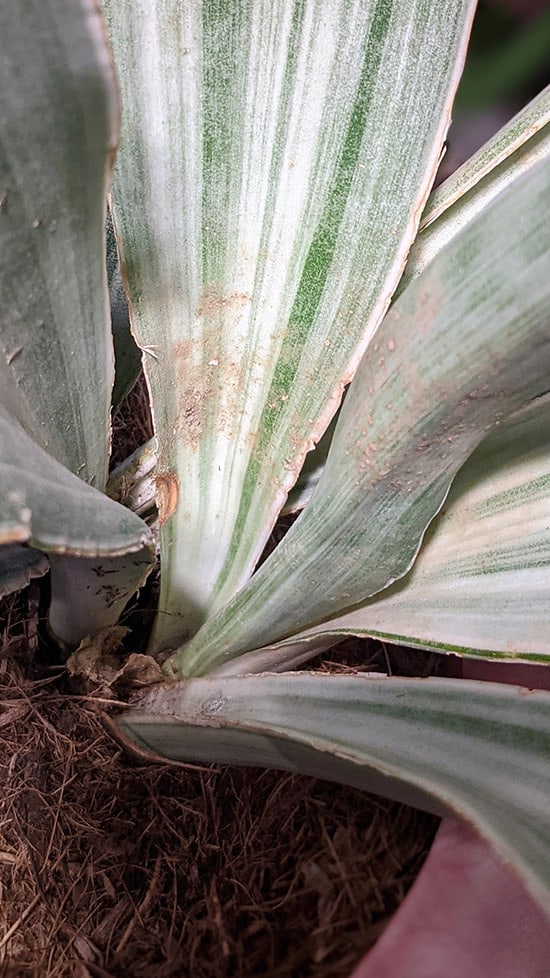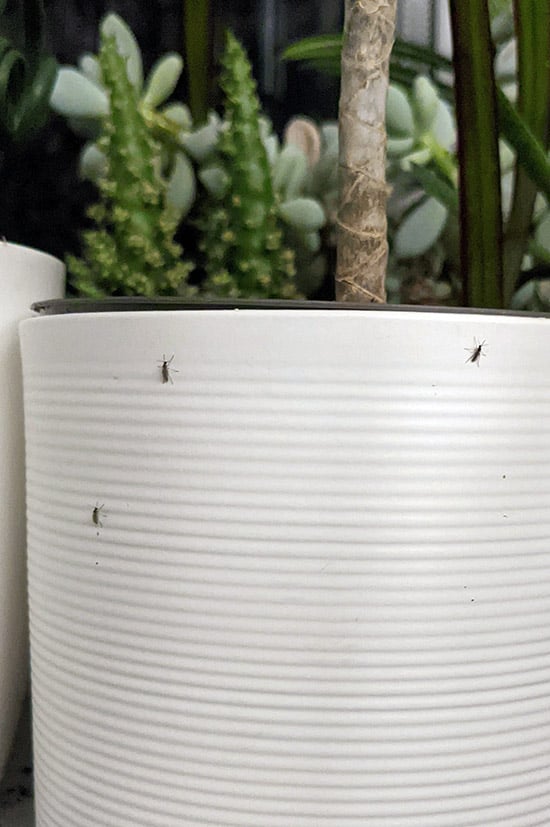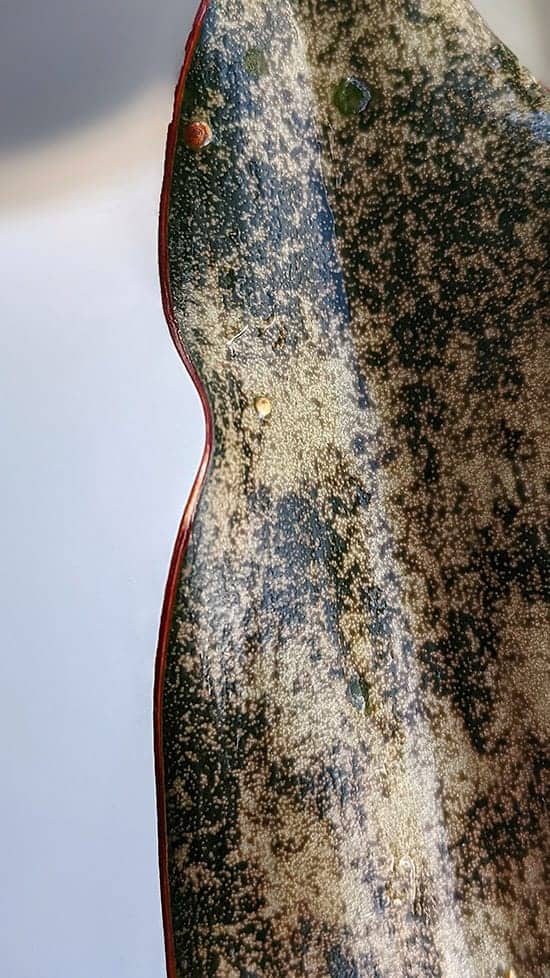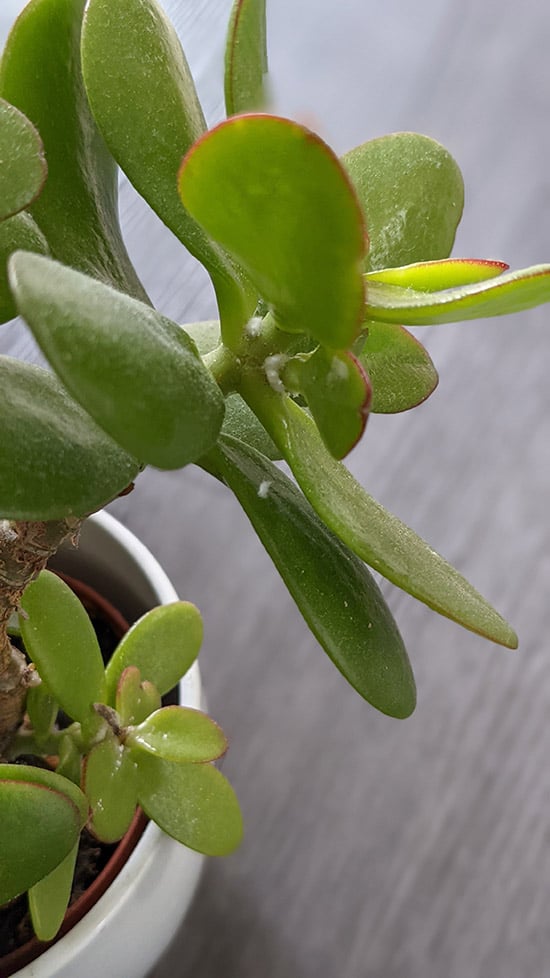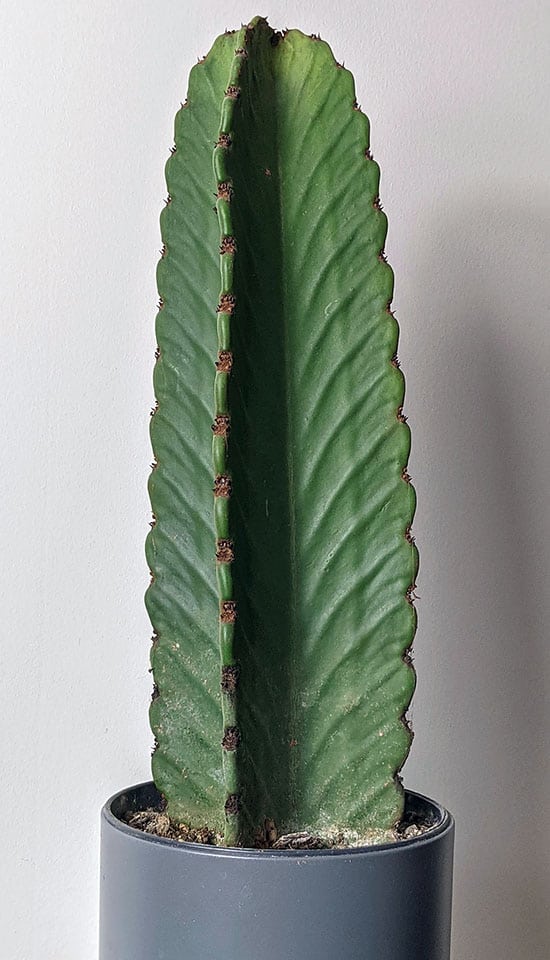Root Rot
This has the potential to be the most common problem succulent plant parents will come across at one time or another. It's an easy mistake to make and if you don't take any action it can seriously damage your plant or finish it off.
An overwatered succulent can attract bacteria or a fungal infection around the roots leading to root rot.
Causes
Although several factors are usually at play, it almost always involves excessive water around the roots.
- Overwatered.
Too much water over a short space of time can trigger root rot. Well-draining soil and drainage holes are the best way to prevent overwatering issues.
- Dense Potting Medium.
If the plant is growing in a very dense potting mix that holds large amounts of water, succulents automatically become way more likely to experience root rot. Typically these plants are adapted to poor soils with a free draining nature. A dense potting medium is the opposite of this.
- Trying to grow the plant in a low light spot or a cold location.
In these types of areas, the plant's metabolic activity slows down. This means they hardly need any water, so it's easy to overdo it with the water accidentally. In comparison, a plant growing in a bright warm location could be perfectly fine with the same amount of watering.
How you deal with root rot depends on how bad or widespread it is. Here is a more detailed guide to root rot.
Stretched Succulent
A stretched or leggy looking plant is a problem that can go unnoticed for several months or longer. But eventually, the visual clues are too obvious to ignore.
This may not seem to be a problem at first glance but look closely, and you can see the newer growth is longer and thinner than the older growth closer to the base of the plant.
Causes
Although people can often propose several causes, only one thing causes a succulent to stretch.
- Insufficient Light.
Most succulents need medium light levels at the bare minimum. Others will need quite a bit more and some will need direct sunlight to do well indoors.
They're not low light plants and if you try and grow them in places like this, you'll eventually see them reaching and stretching towards a nearby light source.
The simple fix is to move them somewhere brighter (or use a grow light). If you're unsure about what's "bright light" then I have a light guide to get you going.
Leaf Drop
Is it normal for leaves to fall off succulents? It can be normal, but in most cases, it's a problem.
Leaves falling off any houseplant can be worrying. It's even worse with succulents, as they tend to have fewer leaves than many other houseplants. A few lost leaves can drastically and quickly change the appearance of your plant.
If you're asking, "Why are my succulent leaves falling off when I touch them?" read on to find out.
Causes
Falling leaves will often be caused by one or two factors coming together simultaneously. This can make it tricky to work out what's caused it. Here are the basic reasons.
- Underwatering.
This won't happen on cacti (they don't have leaves), but any others can lose leaves if they're not watered for long periods.
- Overwatering.
Extreme overwatering will lead to root rot and plant collapse, but even moderate overwatering can result in leaf drop.
- Incorrect Temperatures.
Most can cope with a broad range of temperatures, but if you push things too far, leaf drop can occur.
Brown Spots / Black Spots
Random black or brown spots appearing on leaves can be puzzling.
Dark spots like this could have several causes.
Causes
This is a random issue and can be caused by very different things.
- Overwatering.
Excessive water can cause some brown tips or random patches on the leaves.
- Focused Sun Damage.
This is less common as burns usually destroy an area instead of turning it black, but it can still happen (see issue below).
- Physical Damage.
Either by knocking into it or pests might have fed from the leaves.
- Too low Temperature.
Mild frost damage can quickly turn leaves or parts of the stem black.
- Disease.
Black spot can be caused by fungus and if none of the other issues seem to fit I would lean towards this.
Once parts of the leaf by brown or black like this, you can't reverse it. Either ignore it or remove the affected leaf if you really don't like it.
Brown Sections
Brown sections can look different depending on the issue. There are separate subjects of "Corking" and "Brown Leaves", so check them too.
The plant tissue at the end of the stems has stopped growing and has gone brown.
Causes
Typically these brown sections will be on the ends of the plant stems or exposed areas.
- Physical Damage
Succulents tend to have long lived leaves and stems. Over time damage can occur, like knocking into them by accident.
When this happens to other plants, leaves are easily dropped and replaced, but with succulents, they often try to repair the damage instead. This can result in browning acting as a callous or scab. It's permanent, so take care around any of your plants that are prone to doing this.
- Underwatering.
Insufficient water will often give you shriveling leaves or other signs. But new growth at the tips can be abandoned on some succulents if it's underwatered long term. Far better to shed the new development than lose the older, more established areas.
- Sun Damage.
Intense sunlight can cause scorching. However, it can appear anywhere on the plant where the sun hits it. So it can absolutely affect the ends of the stems or leaves if that's where the sunlight is landing, but it's less likely to happen (because it's such a specific area). The previous suggestions are more likely.
Corking
Corking is characterized by brown sections on a succulent's stem or leaves. This can very easily be mistaken for the previous issue of "brown sections" because they can look like the same thing.
However, corking is slightly different and rarely appears on new fresh growth.
Corking can still happen on healthy succulents, as this Cereus forbesii 'Spiralis' demonstrates.
Causes
It will often start at the bottom of the plant, and although it tends not to spread, it can appear in random patches. Several things can trigger this.
- Age.
Succulents are often long lived and over time, older parts of the plant will age and lose strength and the ability to replace cells. This area is then replaced with a tough, slightly spongy layer.
Corking therefore can be a natural consequence of having a succulent for a long period.
- Damage.
Corking can develop as a form of natural protection from environmental damage, which is explored in a previous issue above.
- Underwater / Overwatering.
It's well known that succulent plants can absorb and store large amounts of water which helps them to survive times of drought. But it's this adaptation that can lead to people adopting a highly irregular watering technique. Doing this can cause the plants cells to expand and contract more than they should, resulting in damage to the outer parts of the plant.
In almost every case, corking is a succulent trying to protect itself or repair damage. You can't reverse it, and in some cases, you can't prevent it.
Take care of your plant and perhaps see it as a sign of maturity and something to be proud of (you have an aged and long lived plant).
Dead Leaves
This only happens on succulents and not cacti. You're looking for leaves drying up and dying.
If the bottom leaves do this or your plant is growing replacement new leaves, this may not be a big issue.
Causes
The reasons this happens are all straightforward and after you've eliminated natural aging, it's almost always down to incorrect care.
- Age.
Older, lower leaves will frequently be lost over the years. It's not always a sign there is a problem. If there are lots of leaves dying at once or it's happening to the newer ones, it will be on the following.
- Not enough water.
Make sure you're giving your succulents enough water and not leaving it too long after the potting medium has thoroughly dried out.
- Too much water.
As a general rule, you can let your succulent completely dry out before you need to think about watering it again. You might overdo it if you keep doing the "little and often" approach. Water thoroughly and then wait until the potting mix has dried out before doing it again.
- Another care need not being met.
A watering issue is the most likely, but not feeding, temperatures being wrong, or too little light can all trigger this to happen.
Mushy Leaves / Stems
This is a nice easy one as it can only be caused by two things. But the bad news is that if it happens, your plant is probably not going to make it.
Cold temperatures and wet soil. A combination you need to work hard to avoid.
Causes
There are only two reasons this would be happening.
- Overwatered.
Succulents are easy going, but they all tend to have a major weakness and that's with water.
Too much of it, even just once, can trigger a collapse as seen in the photo above. It's essential you provide good drainage and let your plant dry out before you water it again.
- Cold Damage.
A mild frost will rip through the plant and cause damage. If the temperature goes too low it could damage it beyond repair. Make sure you bring plants into a warmer space before cold weather sets in.
If the damage isn't too extensive, you might be able to save your overwatered plant.
Brown Leaves
This one is a little different to dead leaves where the entire leaf goes brown and instead you have brown patches appearing.
Although succulents need enough sunlight to do well, too much can cause this to happen.
Causes
This can be confused for corking but is only really caused by one thing.
- Burn Damage.
Strong sunlight will frequently result in red colorings in some succulents with thicker leaves, but when the leaf is relatively thin, intense light will just burn instead.
It might stay like this, or it could fade to a papery white texture. In all cases that green isn't coming back. If you notice this, move it out of the light and somewhere with more shade.
Yellow Leaves
Not all succulents will do this, but if yours has yellow leaves forming them read on to understand why it's happening.
The rest of the plant is healthy. I'm not too worry about these leaves going yellow, but it's obviously not ideal.
Causes
Yellow leaves are caused by the same things that cause yellowing in other types of houseplants.
- Age.
Leaves don't last forever and will eventually be replaced. Providing you're getting at least an equal amount of new growth it's not a concern.
- Not feeding enough.
All plants need at least some nutrients for growth and to maintain the existing foliage.
People who never feed their plants will frequently have weaker growth and yellow leaves.
- Underwatering.
Plants like Euphorbia will often give up their leaves when there is a prolonged water shortage.
- Overwatering.
Often Succulents will simply drop leaves if given excessive water for long periods. But there are a handful of succulents (they normally have thinner leaves) that will let them yellow and brown before falling off.
- Pests.
Over longer periods pests can cause so much damage that the plant decides to absorb the nutrients that are left, turning the leaf yellow in the process before shedding the leaf in an attempt to get rid of the pest. Study your plant carefully for any insects.
Red Leaves
This is quite common on many succulents and what you're looking for is a pink, red or brown tinge in the leaves.
Plants like Haworthias, Aloes and Gastrerias, like this one here, are very prone to this problem.
Causes
Red hues can be natural variegation or a light problem as explained below.
- Natural Markings.
Sometimes the red markings are a normal and natural part of the plant's growth habit. It's particularly common with brand new growth. Over time it should change color and look like the more established growth.
- Too much light.
If established growth is going red, then it's very likely to have been caused by too much sun. Full sun can be too much and the plant tries to protect itself by going red. This is different to burn damage.
Move your plant to a slightly darker spot to prevent more appearing. In many species, when the light level drops the red hues will fade over the next month or so.
Shriveling Leaves
Surprisingly, leaves shriveling on succulents can be fairly common.
An underwatered succulent will often have wrinkled leaves like this.
Causes
When you see this happening it's almost always down to a watering problem.
- Underwatering.
Lack of water will mean the leaves shrink slightly and become wrinkled.
- Overwatering.
Too much water will cause the leaves to swell and cells within the leaf will become damaged, resulting in a shriveling look.
There is more to this topic as well as a number of things you can do to resolve the problem. If your succulent has wrinkling leaves have a read of this.
Disease
Although most succulents and cactus plants can be affected by disease, it's fortunately quite rare and in many cases it's disfiguring and won't "unalive" (finish off) your plant.
Often fungal diseases won't spread too far over the plant because its immune system prevents this. But the damage can still ruin the look.
Causes
Establishing the cause can be almost impossible so I wouldn't bother trying to work it out. Instead follow these tips to minimize it happening.
- Check plants before purchase.
You're far more likely to bring home an affected plant than for it to catch something in your home. Check for any damage or suspicious blemishes or markings.
- Use clean tools during maintenance.
If you're cutting off spent stems or removing faded flowers, make sure your pruning tools are clean.
- Provide good air circulation.
Try and grow your plants somewhere with airflow, this will help reduce airborne spores and bacteria.
- Deal with pests quickly.
The most common way disease will spread to your plant is through pests. Aphids and Thrips can act as carries and spread infections into your plant's tissue. It's important to get a handle on things before they take hold.
If you suspect your succulent has a disease, I have a fuller article with various possibilities.
Fungus Gnats
These flying insects won't harm your plants but they're insanely annoying and can be tricky to get rid of.
A Fungus Gnat pest infestation. Not overly harmful, but maddening and infuriating to most houseplant owners.
Causes
Two main things that cause Gnats to set up home in the potting medium of your plants.
- Poor watering skills.
Gnats love a damp upper surface as it gives them easy access to moisture and helps small amounts of fungus to grow (which provides a food source).
- Infected Potting Medium.
Most infestations occur by using potting soil that already has eggs in it. It can be very hard to screen what you're using.
Even seasoned plant owners will likely struggle with Gnats from time to time and some of it is outside of your control.
Although they aren't particularly harmful, there will come a point where you want them gone and out of your face (literally! They're attracted to our faces because of the carbon dioxide we breathe out). Here's five ways to get rid of Fungus Gnats.
Scale Insects
Scale Insects are my most common succulent pest. They don't tend to exist in large numbers so often don't harm your plant, but even low numbers can still be annoying. They can do a small amount of physical damage to the plant and produce sticky sap.
The real problem is if they're not dealt with they can reproduce and reach a damaging population level that saps energy and can prevent or slow growth.
Scale Insects can really hold on, like Barnacles on a rock at a beach. A cotton swab dipped in rubbing alcohol can help remove them.
Causes
Scale Insects can only infect your plants if they enter your home.
- You've brought an infected houseplant home.
Make it a habit to observe new purchases for pests. Scale Insects tend not to move once they've locked on to your plant so you won't usually see movement. Instead, carefully look over all the leaves for the tell tail small brown discs.
- You've put them outside for the summer months.
Scale Insects do not travel far by themselves, but they do exist in gardens so if you've inadvertently put your plants next to a colony they could set up home.
Mealy Bugs
I rarely get Mealy Bugs on my foliage plants but they do show up more on some succulents.
Mealy Bugs tend to be covered in what looks like harmless white fluff. It's easy to overlook but can be a problem if you don't deal with them.
Causes
Compared to plants growing outdoors, pests indoors are often rare but something will show up eventually. It's almost a certainty of being a plant parent!
- You've brought an infected houseplant home.
This is the most common way pests find their way into a collection. You just need a few hidden bugs on your new plant and before long they've made their way to the other plants in your home.
Pay close attention to any new plants or consider an isolation period
where you can watch for any creepy crawlies.
- They've come in through an open window or door.
Less likely, but clearly if there is an open space any bug from outside could make its way inside.
Adult Mealy Bugs are very easy to treat due to their limited number and size. Insecticidal soap or neem oil are your friends.
The actual issue here is not noticing the tiny offspring which then grow and return to replace the adult bugs you've removed. Here is our pest guide for more.
No Growth
Noticing your succulent isn't growing is one of the longest problems to spot. Things tend to look perfectly normal and healthy, but there just isn't any new growth being produced.
My Euphoria Ingens hasn't produced any new green growth in years.
Causes
This can have a few reasons caused by the growing situation. The good news is that in most cases your plant is "waiting" for things to improve and when that happens growth should start.
- The succulent has seasonal growth.
Some plants will store and gather energy and they suddenly use it for growth over a few months each year. After this, they "freeze" and no matter what you do, you won't get anything new until the following year.
Many Euphorbia and some Cacti are prone to this (only really growing from mid-summer). It's a quirk of the plant and realistically can't be easily adjusted.
- The container is too small.
Generally speaking, the larger the plant is, the greater number of roots it will have. Many plants can sense their root space. Once they reach the edges or the bottom of the pot, the plant must decide if it wants to risk producing new growth based on available resources and space. The solution is to consider up-sizing (repotting).
- Not feeding your plant.
Succulents can live in the same pot for many years, but they will still require occasional feeding to fuel growth. A repot or starting to feed on a more regular basis can
give the boost it needs to grow.
- Poor growing conditions.
Not meeting the basic care requirements can stress your plant. If its struggling to get by at it's current size, it will certainly not have spare resources to grow.
That's my list of common succulent problems and how to fix them. Need more help? Have I missed an issue? Let me know below.
About the Author
![Tom Knight Tom Knight]()
Tom Knight
Over the last 20 years, Tom has successfully owned hundreds of houseplants and is always happy to share knowledge and lend his horticulture skills to those in need. He is the leading content writer for the Ourhouseplants Team.
Also on Ourhouseplants.com
Comments

